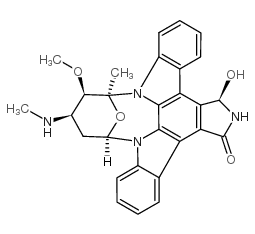UCN-01

UCN-01 structure
|
Common Name | UCN-01 | ||
|---|---|---|---|---|
| CAS Number | 112953-11-4 | Molecular Weight | 482.53000 | |
| Density | 1.63g/cm3 | Boiling Point | 705.7ºC at 760mmHg | |
| Molecular Formula | C28H26N4O4 | Melting Point | N/A | |
| MSDS | Chinese USA | Flash Point | 380.6ºC | |
|
Nitric oxide donors increase PVR/CD155 DNAM-1 ligand expression in multiple myeloma cells: role of DNA damage response activation.
BMC Cancer 15 , 17, (2015) DNAX accessory molecule-1 (DNAM-1) is an activating receptor constitutively expressed by macrophages/dendritic cells and by T lymphocytes and Natural Killer (NK) cells, having an important role in anticancer responses; in this regard, combination therapies ab... |
|
|
Induction of DNA damage and G2 cell cycle arrest by diepoxybutane through the activation of the Chk1-dependent pathway in mouse germ cells.
Chem. Res. Toxicol. 28(3) , 518-31, (2015) 1,2:3,4-Diepoxybutane (DEB) is a major carcinogenic metabolite of 1,3-butadiene (BD), which has been shown to cause DNA strand breaks in cells through its potential genotoxicity. The adverse effect of DEB on male reproductive cells in response to DNA damage h... |
|
|
The epithelial polarity regulator LGALS9/galectin-9 induces fatal frustrated autophagy in KRAS mutant colon carcinoma that depends on elevated basal autophagic flux.
Autophagy 11 , 1373-88, (2015) Oncogenic mutation of KRAS (Kirsten rat sarcoma viral oncogene homolog) in colorectal cancer (CRC) confers resistance to both chemotherapy and EGFR (epidermal growth factor receptor)-targeted therapy. We uncovered that KRAS mutant (KRAS(mut)) CRC is uniquely ... |
|
|
Coated chitosan nanoparticles encapsulating caspase 3 activator for effective treatment of colorectral cancer.
Drug Deliv Transl Res 5 , 596-610, (2015) Cancer is the second leading cause of death worldwide, the deaths are projected to continue rising, with an estimated 12 million deaths in 2030. The aim of the present investigation is to prepare and compare the uncoated (U-CH NP) and eudragit S 100-coated (E... |
|
|
Reactive oxygen species- and DNA damage response-dependent NK cell activating ligand upregulation occurs at transcriptional levels and requires the transcriptional factor E2F1.
J. Immunol. 193(2) , 950-60, (2014) Increasing evidence indicates that cancer cell stress induced by chemotherapeutic agents promote antitumor immune responses and contribute to their full clinical efficacy. In this article, we identify the signaling events underlying chemotherapy-induced NKG2D... |
|
|
SC-III3, a novel scopoletin derivative, induces cytotoxicity in hepatocellular cancer cells through oxidative DNA damage and ataxia telangiectasia-mutated nuclear protein kinase activation.
BMC Cancer 14 , 987, (2015) Natural products from plants have been proven to be important resources of antitumor agents. In this study, we exploited the antitumor activity of (E)-3-(4-chlorophenyl)-N-(7-hydroxy-6-methoxy-2-oxo-2H-chromen-3-yl) acrylamide (SC-III3), a newly synthesized d... |
|
|
Simian virus 40 large T antigen induces IFN-stimulated genes through ATR kinase.
J. Immunol. 192(12) , 5933-42, (2014) Polyomaviruses encode a large T Ag (LT), a multifunctional protein essential for the regulation of both viral and host cell gene expression and productive viral infection. Previously, we have shown that stable expression of LT protein results in upregulation ... |
|
|
Staurosporine, K-252 and UCN-01: potent but nonspecific inhibitors of protein kinases.
Trends Pharmacol. Sci. 10(6) , 218-20, (1989)
|
|
|
Caffeine suppresses homologous recombination through interference with RAD51-mediated joint molecule formation.
Nucleic Acids Res. 41(13) , 6475-89, (2013) Caffeine is a widely used inhibitor of the protein kinases that play a central role in the DNA damage response. We used chemical inhibitors and genetically deficient mouse embryonic stem cell lines to study the role of DNA damage response in stable integratio... |
|
|
Staurosporine analogs promote distinct patterns of process outgrowth and polyploidy in small cell lung carcinoma cells.
Tumour Biol. 36(4) , 2725-35, (2015) We have recently shown that staurosporine mediates the conversion of small cell lung carcinoma (SCLC) cells into a neuron-like process-bearing phenotype. Here, we have extended these studies to the staurosporine analogs K252a, lestaurtinib, PKC412, stauprimid... |